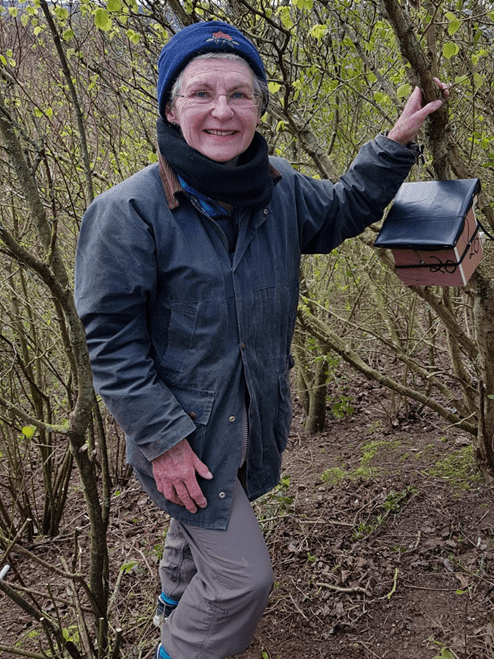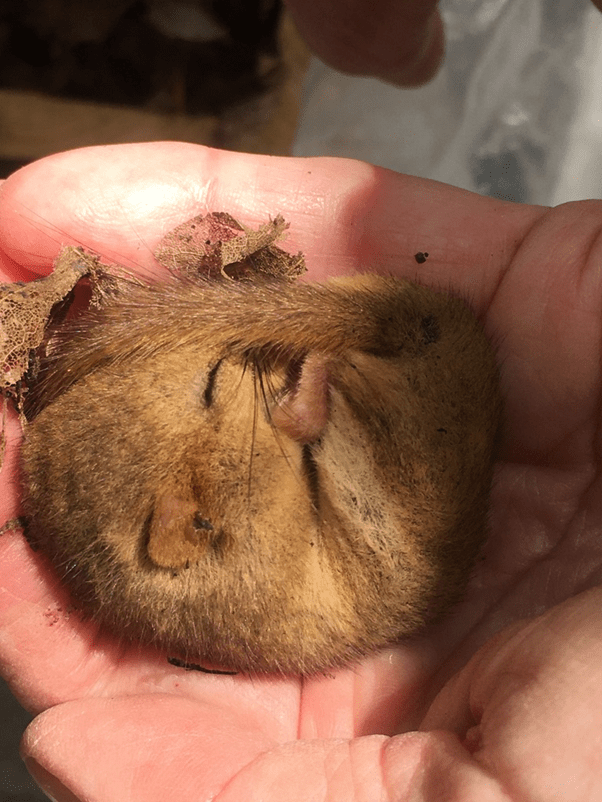Meet Sally Wadsworth: dormouse monitor
In this series, we chat to the dedicated staff members, conservation partners and volunteers at PTES. We find out why each of them chose a career in wildlife conservation, what they find rewarding about their work and what they love most about what they do.
Sally Wadsworth
Dormouse monitor in Brighton
Tell us about yourself and the site you monitor
Hi, I’m Sally and I’ve been passionate about wildlife, nature and conservation all my life. I wasn’t lucky enough to work in any of these fields so I’ve only been able to get actively involved since I retired in 2019.
My site is on a steep chalk escarpment, close to the edge of the Brighton bypass in East Sussex. The slope, which has been invaded by scrubby woodland, has two clearings in the middle. It’s a long, linear site which runs along the edge of the bypass and a bridle way.
How long have you been monitoring for?
I got my handling licence in December 2018. I was lucky enough to have Ian White, PTES’s Dormouse Officer, as one of my trainers, having been on his intensive course on the Isle of Wight. Stephen Robinson also took me monitoring in the Loder Valley in Sussex. Now I’m in my fifth year monitoring the site.
What’s the most memorable day you’ve had looking for dormice?
Well, I wasn’t actually looking for dormice. It was January 2022, and we were planting whips in one of the open areas to improve habitat connectivity. I was given the whips free as part of a Network Rail biodiversity net gain project.
It was a bright, sunny but cold January morning. Imagine my surprise when I noticed a hibernating dormouse at my feet, just lying on the open chalk grassy slope. It was lucky I didn’t tread on him, or her. I was so surprised that I didn’t even think to take a picture, but just beat a hasty retreat, watching my every step in case there was another one! Should I have moved it to somewhere sheltered, I wondered later?
Describe your woodland and why it’s special to you
Much of the woodland is on steep slopes. The main tree species are hazel, dogwood, hawthorn, some ash (without die-back so far!) wild cherry, wayfarer, spindle, bramble, plus old man’s beard. The more open areas are interspersed with beautiful, chalk grassland wildflowers. There’s even a white helleborine orchid right under box number 13. These are on the vulnerable list for flora. Every year I make sure I don’t tread on it.
The reason it’s special to me is that, for years, I suspected there were dormice present. Not only have I proved there are, but they appear to be doing very well. I have 25 boxes across the site and last June and July (2022) I recorded ten dormice each month, including young.
If this year’s anything to go by, I might break my site record. I found six adults in April, three of them in torpor, five adults and two litters in May, and five adults – including one pregnant female and two litters of five grey-eyes-closed – in June 2023.
What are the challenges at the site?
The biggest challenge is the terrain. Sometimes, when I’m opening a box in the large bag, I have one foot about 30 centimetres higher than the other. There are very few flat areas where I can place the bag and box level. This has led to one or two escapes.
Interestingly, the dormice don’t seem to mind the Brighton Bypass traffic thundering by. But it can be quite deafening and I don’t like it.
Tell us something about you we wouldn’t expect from a dormouse monitor
Dormice are very terrestrial, but I love the water. I’m a keen swimmer and used to enjoy scuba diving, exploring the underwater wildlife in the English Channel. But I think you’ll agree that dormice are much cuter than conger eels!
Can you help us reintroduce more dormice to the wild?


